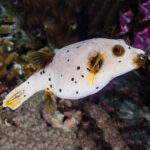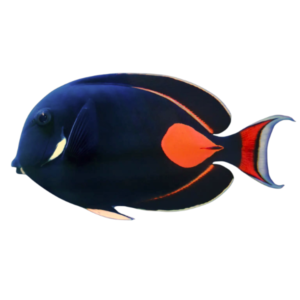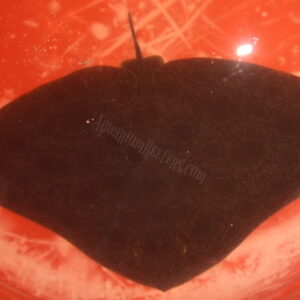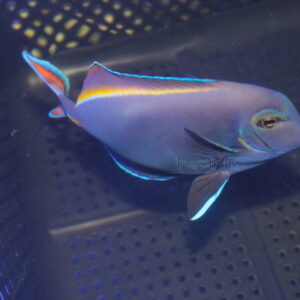Description
The Oriental sweetlips, scientifically known as Plectorhinchus orientalis, is a visually striking fish species that boasts a distinctive appearance. It can reach a maximum size of around 20 inches (50 centimetres) in length. The body of the Oriental sweetlips is elongated and compressed laterally, with a slightly curved dorsal profile. Its colouration is captivating, featuring a vibrant white spots on a deep background. The head is notably large, complemented by protruding lips that give the fish its name.
Taxonomy
Belonging to the genus Plectorhinchus, the Oriental sweetlips is a member of the family Haemulidae, commonly known as the grunt or sweetlips family. This family comprises various species of marine fishes characterized by their strong, grinding teeth. The closest relatives of the Oriental sweetlips within the genus Plectorhinchus include the Blackspotted sweetlips (Plectorhinchus gaterinus) and the Harlequin sweetlips (Plectorhinchus chaetodonoides). The genus name “Plectorhinchus” is derived from the Greek words “plektron” (meaning “stinger” or “spur”) and “hynchos” (referring to a fish snout), alluding to the distinctive snout shape of these fish.
Natural Habitat
The natural habitat of the Oriental sweetlips is characterized by coral reefs and rocky areas in tropical and subtropical waters. These vibrant underwater ecosystems are teeming with a diverse array of marine life, providing ample food sources and hiding places for the fish. The Oriental sweetlips can often be found dwelling in caves, crevices, and coral heads, seeking shelter during the day and venturing out to forage at night. The reef environment is rich in coral formations, which provide an abundance of hiding spots and attract a variety of prey organisms.
Keeping Oriental Sweetlips Healthy:
The care level for Oriental sweetlips is moderate, requiring some experience and attention to ensure their well-being. Maintaining suitable water conditions is crucial, including a temperature range of 75-82°F (24-28°C) and a pH level between 8.1 and 8.4. Regular water testing and quality monitoring are necessary to prevent any fluctuations that may harm the fish. A spacious tank with a minimum capacity of 100 gallons (380 litres) is recommended to accommodate the size and swimming habits of the Oriental sweetlips.
Special Requirements and Feeding
Oriental sweetlips have special dietary requirements, primarily consisting of meaty foods. Their diet should include a variety of live or frozen seafood such as shrimp, squid, clams, and fish flesh. Offering a balanced diet and providing regular feedings throughout the day helps promote optimal health and growth. It is essential to monitor their feeding habits to ensure they consume an adequate amount of food and maintain a healthy appetite.
How Many Should I Keep?
When considering how many Oriental sweetlips to keep, it is crucial to consider their territorial nature and the available space in the aquarium. Due to their size and potential aggression towards conspecifics, it is advisable to keep only one Oriental sweetlips per tank. This ensures that each fish has enough space and reduces the likelihood of territorial disputes or aggression.
Lighting Preference
Oriental sweetlips do not have specific lighting preferences. However, providing a well-lit aquarium with a mixture of ambient and direct lighting mimics their natural environment and showcases their vibrant colouration. The use of appropriate lighting fixtures, such as LED lights, can enhance the visual appeal of the fish and the overall aesthetics of the tank.
Reproduction in the Wild
In the wild, the Oriental sweetlips (Plectorhinchus orientalis) engage in a fascinating reproductive process. These fish are oviparous, meaning they reproduce by laying eggs. During the breeding season, which varies depending on the region, Oriental sweetlips gather in large groups near coral reefs to commence their reproductive activities.
Breeding Plectorhinchus orientalis:
- Set up
When breeding Oriental sweetlips in captivity, certain steps need to be followed to ensure a successful process. The breeding setup should include a spacious tank with stable water conditions, ideally maintained at a temperature of 77-82°F (25-28°C) and a pH level between 8.1 and 8.4. Adequate hiding places, such as caves or PVC pipes, should be provided for the fish to lay their eggs.
- courtship and spawning
The courtship and spawning behaviour of Oriental sweetlips involves an intricate dance between the male and female. The male initiates courtship by displaying vibrant colours, erecting its fins, and engaging in vigorous swimming patterns to attract the female. Once courtship is established, the pair ascends together towards the water’s surface, where the female releases a large number of eggs while the male simultaneously releases his sperm.
- rearing
Following the spawning process, it is crucial to remove the adult fish from the breeding tank to prevent them from consuming the eggs. The fertilized eggs will adhere to surfaces such as rocks or the sides of the tank. After a period of approximately 24 hours, the eggs will hatch, and the larvae will begin their development.
During the rearing phase, the newly hatched larvae require specialized care. They are highly sensitive to water quality and temperature fluctuations. Maintaining pristine water conditions and providing a suitable diet of live rotifers and brine shrimp nauplii is essential for their growth and survival. As they mature, the larvae undergo metamorphosis, gradually acquiring the appearance and characteristics of adult Oriental sweetlips.
Sexual Dimorphism
Sexual dimorphism in Oriental sweetlips is not prominent. Both males and females possess similar body shapes, colour patterns, and fin structures. It can be challenging to visually distinguish between the sexes based on external characteristics alone.
Distribution
The Oriental sweetlips, Plectorhinchus orientalis, is native to the Indo-Pacific region, spanning from the Red Sea and the eastern coast of Africa to the waters of Southeast Asia and northern Australia. While captive-bred and line-bred strains may be available in the aquarium trade, the original wild-caught fish originate from the aforementioned regions.
Summary
The Oriental sweetlips, scientifically known as Plectorhinchus orientalis, is a visually captivating fish species characterized by its elongated body and vibrant patterns. These fish prefer coral reefs and rocky areas in tropical and subtropical waters as their natural habitat.
Maintaining optimal conditions, such as suitable water parameters and a spacious tank, is crucial for keeping Oriental sweetlips healthy. They require a meaty diet consisting of live or frozen seafood. It is advisable to keep only one Oriental sweetlips per tank due to their territorial nature.
When breeding Oriental sweetlips, a well-prepared setup and careful attention to courtship and spawning behaviours are necessary. The larvae require specialized care, including pristine water conditions and a proper diet, for successful rearing.
Sexual dimorphism in Oriental sweetlips is not readily apparent, making it challenging to differentiate between males and females based on external characteristics alone.
The Fish pictured here are representative only and the livestock you receive may vary in pattern, coloration, and shape.









Reviews
There are no reviews yet.